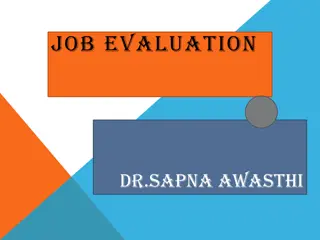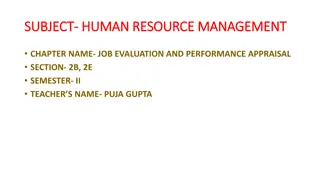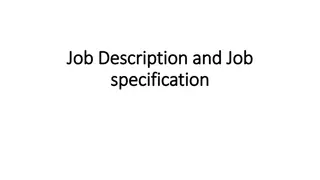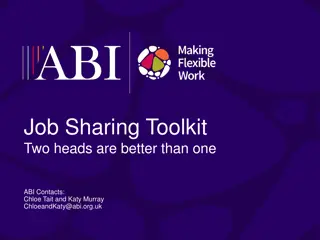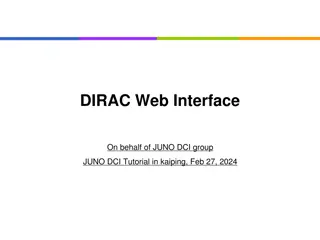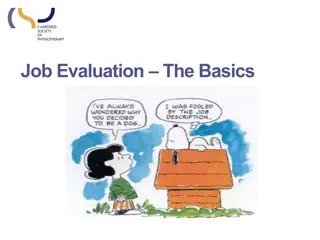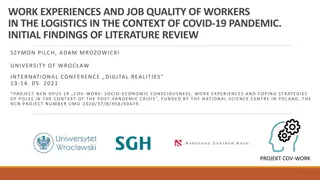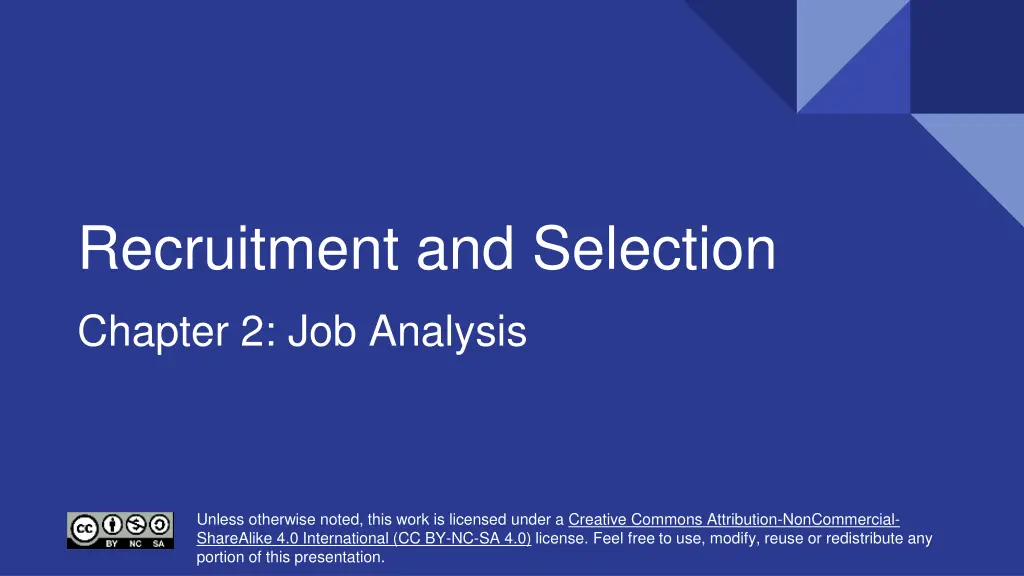
Understanding Job Analysis in Human Resource Management
Job analysis is a crucial element in HR functions, supporting recruitment, training, performance appraisal, and more. It involves key elements like job description, job specification, and competencies, with various methods for data collection. Job analysis ensures legal compliance, accurate job descriptions, and aligns HR practices with organizational goals. Learn about the importance, process, and outcomes of job analysis in this comprehensive guide.
Uploaded on | 0 Views
Download Presentation

Please find below an Image/Link to download the presentation.
The content on the website is provided AS IS for your information and personal use only. It may not be sold, licensed, or shared on other websites without obtaining consent from the author. If you encounter any issues during the download, it is possible that the publisher has removed the file from their server.
You are allowed to download the files provided on this website for personal or commercial use, subject to the condition that they are used lawfully. All files are the property of their respective owners.
The content on the website is provided AS IS for your information and personal use only. It may not be sold, licensed, or shared on other websites without obtaining consent from the author.
E N D
Presentation Transcript
Recruitment and Selection Chapter 2: Job Analysis Creative Commons Attribution-NonCommercial-ShareAlike 4.0 International (CC BY-NC-SA 4.0) Creative Commons Attribution-NonCommercial-ShareAlike 4.0 International (CC BY-NC-SA 4.0) Unless otherwise noted, this work is licensed under a Creative Commons Attribution-NonCommercial- ShareAlike 4.0 International (CC BY-NC-SA 4.0) license. Feel free to use, modify, reuse or redistribute any portion of this presentation.
Learning Outcomes Understand how job analysis is a foundational element in human resource functions, supporting recruitment, selection, training, performance appraisal, compensation, and succession planning. Describe the key elements of a job analysis, including job description, job specification, and competencies, and identify methods used to collect job analysis data. Compare and contrast task-based job analysis, focusing on specific tasks and duties, with competency-based job analysis, emphasizing skills and personal attributes required for job performance. Describe the steps in conducting a job analysis, including planning, data collection, data analysis, and documentation, to ensure accurate and comprehensive results.
Learning Outcomes Cont. Analyze how job analysis supports legal compliance with employment standards and regulations and helps ensure that HR practices align with organizational goals. Assess how job analysis data is used to create accurate job descriptions that outline a position s duties, responsibilities, qualifications, and working conditions. Identify and evaluate various data sources for job analysis, such as interviews, surveys, observations, and work logs, to gather comprehensive information about a job.
2.0 Introduction A job analysis is one of the most critical human resource management tasks. It is the foundation of human resources management. Job analysis data supports almost all HR activities, such as training and development, performance appraisal, health and safety, HR planning, compensation and recruitment and selection. Photo by Scott Graham Unsplash License
2.1 Job Analysis Jobanalysis is a formal system developed to determine which tasks people perform. The purpose is to ensure the right fit between the job and the employee and to determine how employee performance will be assessed. A significant part of the job analysis includes research, which may mean reviewing the job responsibilities of current employees, researching job descriptions for similar jobs with competitors, and analyzing any new responsibilities needed by the person in the position. Photo by Towfiqu barbhuiya Unsplash License
2.2 Task Competency Job Analysis Two types of job analyses can be performed: task-based and competency-based. A task-based analysis focuses on the job s duties, while a competency-based analysis focuses on the specific knowledge and abilities a worker must have for successful job performance. The focus of task-based analyses is the job duties required, while the focus of competency- based analyses is on how a person can apply their skills to perform the job. Photo by Andrew Neel Unsplash License
2.3 Job Analysis Process Select Jobs To Study Determine Information Needed Identify Sources Of Data Determine Methods Of Data Collection Evaluate and Verify Data Use Data to begin writing the analysis
2.4 Methods Of Data Collection Structured questionnaire and open-ended questionnaire A questionnaire is probably the most common method used to elicit job-related information. It is relatively inexpensive, and you can access information from many workers. Structured Interview In a face-to-face interview, the interviewer obtains the necessary information about the work done by individuals or small groups of employees and supervisors. Photo by Lukas Blazek Unsplash License
2.4 Methods Of Data Collection Cont. Observation Employees are directly observed performing job tasks, and observations are translated into essential job-related information. Work diary or log A work diary or log is a record maintained by the employeeand includes the frequency and timing of tasks. The employee keeps logs over days or weeks. Photo by The Jopwell Collection Unsplash License
2.5 Job Description A job description is a written statement of what a position entails: what is done, how it s done and under which conditions. By combining the job description tasks, duties, and responsibilities with the job specification knowledge, skills, and abilities, you have all the data needed to write a job description. Photo by Scott Graham Unsplash License
Key Takeaways Foundation of HRM: Job analysis is a fundamental component of human resource management, supporting various HR activities such as training and development, performance appraisal, health and safety, HR planning, compensation, recruitment, and selection. Purpose: The main aim of job analysis is to define what a job involves, including the required knowledge, skills, abilities, and other attributes (KSAOs), as well as job tasks, duties, responsibilities (TDRs), and working conditions. Specifying Job and Person Requirements: Before conducting a job analysis, consider if the job needs to be filled or updated. This stage is an opportunity to assess organizational needs and the person-organization fit, ensuring that the job aligns with the company s strategic goals.
Key Takeaways Cont. Process Steps: The job analysis process involves selecting jobs to study, determining the necessary information (TDRs and KSAOs), identifying data sources, and deciding on data collection methods. Data is then used to write job descriptions and specifications. Data Collection Methods: Common methods include structured and open-ended questionnaires, structured interviews, observation, and work diaries/logs. These tools help gather comprehensive information about job roles, though each method has its advantages and limitations. Task vs. Competency-Based Analysis: Task-based analysis focuses on specific job duties, while competency-based analysis emphasizes the skills and abilities required for job performance. Each serves different purposes, with task-based analysis suited for more routine roles and competency-based analysis for higher-level positions.
Key Terms Competency-Based Job Analysis: A method of job analysis that focuses on the specific skills, behaviours, and abilities needed for successful job performance. Methods of Data Collection: Various techniques are used to gather information for job analysis, including interviews, questionnaires, observations, and work diaries. Job Analysis: A systematic process used to identify and document the tasks, duties, responsibilities, and required qualifications of a job. National Occupational Classification (NOC): A standardized classification system in Canada that categorizes occupations based on job descriptions, skills, and duties.
Key Terms II O*NET: The Occupational Information Network, a U.S.-based database that provides comprehensive information about job requirements, worker characteristics, and occupational attributes. Performance Appraisal: The process of evaluating an employee s job performance against established criteria. Structured Questionnaire: A data collection tool used in job analysis that contains specific, predefined questions to gather consistent information from respondents. Subject Matter Experts (SMEs): Individuals with specialized knowledge and expertise about a particular job or field. Task-Based Job Analysis: A job analysis method that focuses on identifying and documenting the tasks and duties performed.
Key Terms III Tasks, Duties, and Responsibilities (TDRs): The specific actions and obligations associated with a job. Work Diary/Log: A record maintained by an employee documenting the frequency and timing of job tasks.







